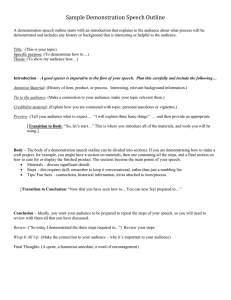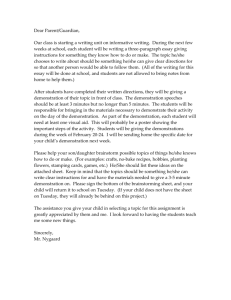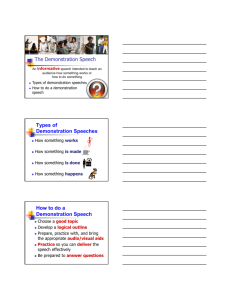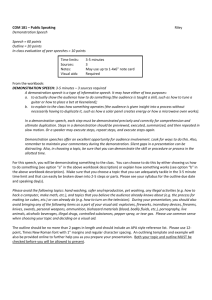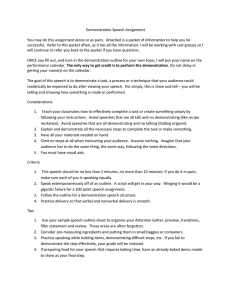Oral Communication - An
advertisement
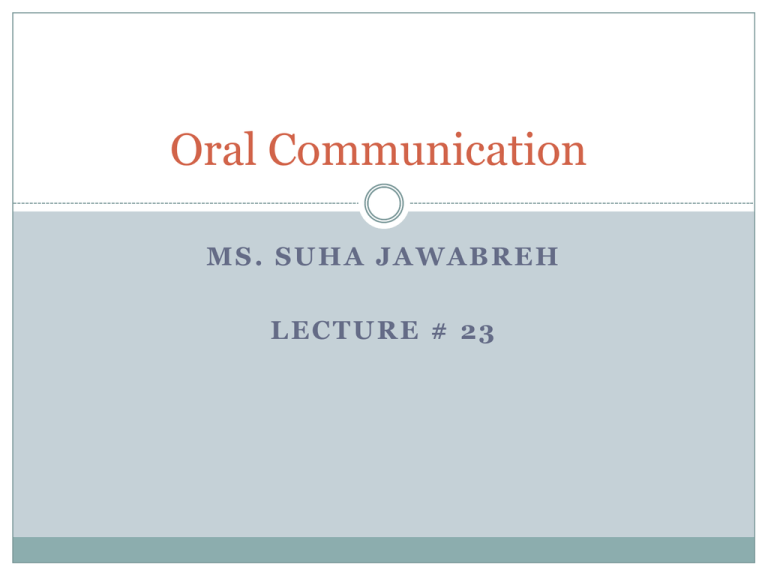
Oral Communication MS. SUHA JAWABREH LECTURE # 23 Types of Speeches 1. Speech to demonstrate 2. Speech to inform 3. Speech to persuade 4. Speech to entertain 5. Oral interpretations/ Dramatic reading Speech to demonstrate What is a demonstration speech? A demonstration speech is a form of informative speech where the speaker’s primary purpose is to teach the audience how to complete a task (or process), and this is largely accomplished by demonstrating the task (or process) through a series of steps. What are some examples of demonstration speech topics? How to prepare a recipe (as in standard cooking shows) How to operate a software application How to tie a knot How to calculate a mortgage payment How to swim the backstroke How to process a purchase order How to set up a blog The Demonstration Speech Outline How to Organize a demonstration speech -Start with why -Give a brief overview of the entire process -Go through the steps, one-by-one -For each, describe it, then show it (Optional) Discuss options, extras, or variations -Allow time for Q&A -Summarize briefly 1. Start with why -A demonstration speech is about training the audience to perform a task or complete a process. -This is why it’s important to tell your audience how they will benefit from the knowledge you are about to share. Once your audience knows why they are learning this new task, they will be motivated to learn. -There are many ways to motivate your audience, but one of the best ways is to open with a story. Paint a picture of how their life will improve with this new knowledge. Will learning this new task or process help your audience: Earn or save money? Earn a promotion? Build their range of skills? Save them time? Make their life easier? Provide enjoyment or satisfaction? Make them happy? 2. Give a brief overview of the entire process -Before you dive too deep in the details, it is essential to present an overview of the overall task or process. -A brief, high-level overview of the steps involved provides a mental framework for the audience upon which they can hang the details as you provide them later in the speech. -When learning a new task, some people in your audience will fear that it is complicated. An early overview assures your audience that it is not overly complex. For example, “We’re going to discuss how to cook this in just four easy steps…” -If you fail to present an outline, it’s difficult for your audience to see how the steps will fit together later on. The audience won’t have the necessary context. -A great way to present the overview is with a diagram illustrating the steps of the task at a high level. You can refer to this diagram throughout. -Along with the overview, you should also list the prerequisites needed for the task, and any assumptions you are making. For example, what is needed before one begins this task? What supplies or resources are assumed? 3. Go through the steps, one-by-one -From a speaker’s perspective, one of the best things about a demonstration speech is that the core of your outline is prepared for you: you simply need to go through the steps of the task in sequential order. -Keep the series of steps as simple as possible. Break the process down to the most essential steps that will lead your audience successfully from start to finish. -There’s no “best” number of steps, but keep the number of steps as low as possible. Don’t present a 19-step process unless your goal is utter confusion. For each step, you should: -Explain the purpose of the step (why is this step necessary) -Explain the step in simple, straightforward language (what needs to be done) -Show how to complete the step (how should it be done) 4. Allow time for Q&A -This allows the audience to seek clarification on any of the steps which were unclear. -Depending on your topic and the forum in which you are speaking, you may choose to take questions at the end, or you may invite questions throughout your demonstration. Either way, monitor your time. 5. Summarize briefly Finally, you should summarize the process briefly, and recap the benefits which your audience will realize if they perform the desired process or task. How to Elevate Your Demonstration Speech -There are many ways that you can elevate the quality of your content and the manner in which you present it to maximize the effectiveness for your audience: A. If you can, get audience members doing it. If the situation doesn’t allow for you to involve the whole audience, try to get one or more audience members to help you out as volunteers. B. Visuals are critical for a demonstration speech. 1. Your body is often the best visual. 2. Physical props make it real. (real and fake) 3. Use photographs or diagrams as necessary. C. Extend your demonstration by providing follow-up resources. It helps to provide resources they can use after your demonstration is complete, this includes: -Websites, books, pamphlets, or other expert sources which they can consult for deeper information, or more advanced training. -Handouts you prepare which summarize the steps in the process, as well as diagrams or photographs which illustrate key details. -Contact details. What do you like or dislike about demonstration speeches? Do you have any tips to share about how to give an excellent demonstration speech? Or maybe you’ve witnessed some particularly good or bad demo speeches?
